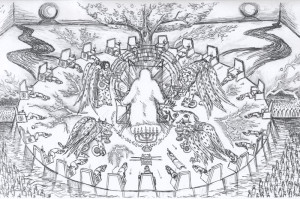
What does Revelation imply about God, Jesus, and worship?
In Revelation chapter 4, the author is granted a heavenly vision:
After this I looked, and behold, a door standing open in heaven! And the first voice, which I had heard speaking to me like a trumpet, said, “Come up here, and I will show you what must take place after this.” At once I was in the Spirit, and behold, a throne stood in heaven, with one seated on the throne. (ESV, emphases throughout are added)
Awesome. Who could this be? There follows a description of the setting and the heavenly court. Featured are some wierd heavenly beings singing,
“Holy, holy, holy, is the Lord God Almighty, who was and is and is to come!”
Right – this is Yahweh. All of this is very reminiscient of the vision in Isaiah chapter 6:
In the year that King Uzziah died I saw the Lord sitting upon a throne, high and lifted up; and the train of his robe filled the temple. Above him stood the seraphim. Each had six wings: with two he covered his face, and with two he covered his feet, and with two he flew. And one called to another and said:
“Holy, holy, holy is the LORD of hosts; the whole earth is full of his glory!”
“LORD” here is the proper name Yahweh. So this is who Isaiah saw. And this, the author of Revelation is telling us, who he now sees in his vision. Much in the vision is similar to the visions in Ezekiel 1 and 10. There too, the prophet sees God himself.
If the point wasn’t clear enough in Revelation 4, some worship this one on the throne, saying,
“Worthy are you, our Lord and God, to receive glory and honor and power, for you created all things, and by your will they existed and were created.”
This recalls well-known passages later in Isaiah, were Yahweh asserts that he’s the only true God, and the only creator.
Note finally that the author here nowhere says the one on the throne is a man, although one imagines the character as humanoid – I mean, appearing to be similar to a man – he does sit enthtroned here, and in the next chapter he’s got a scroll in his right hand. Of course, he’s assumed to be a self here too. He has a will, he performs intentional actions like creating, and he can be addressed and worshiped.
He’s a glorious and powerful being here, but the author demurs from directly describing him. I think that’s why a good portrayal of this scene has a sort of non-descript person on the throne, e.g. with no articulated face, as in the picture here (which is really of Revelation 5, subject of my next post).

Pingback: Worship and Revelation 4-5 – Part 5 – An Objection (Dale) » trinities
Pingback: Worship and Revelation 4-5 – Part 3 – Revelation 5 (Dale) » trinities
Yes, it is interesting. I think only unitarians have a good explanation for this.
Interesting that the 3rd Person of the Trinity, “God the Holy Spirit”, does not get His own introduction chapter. Let alone a “throne” at the end of all things [Rev 22]. 😛
Comments are closed.